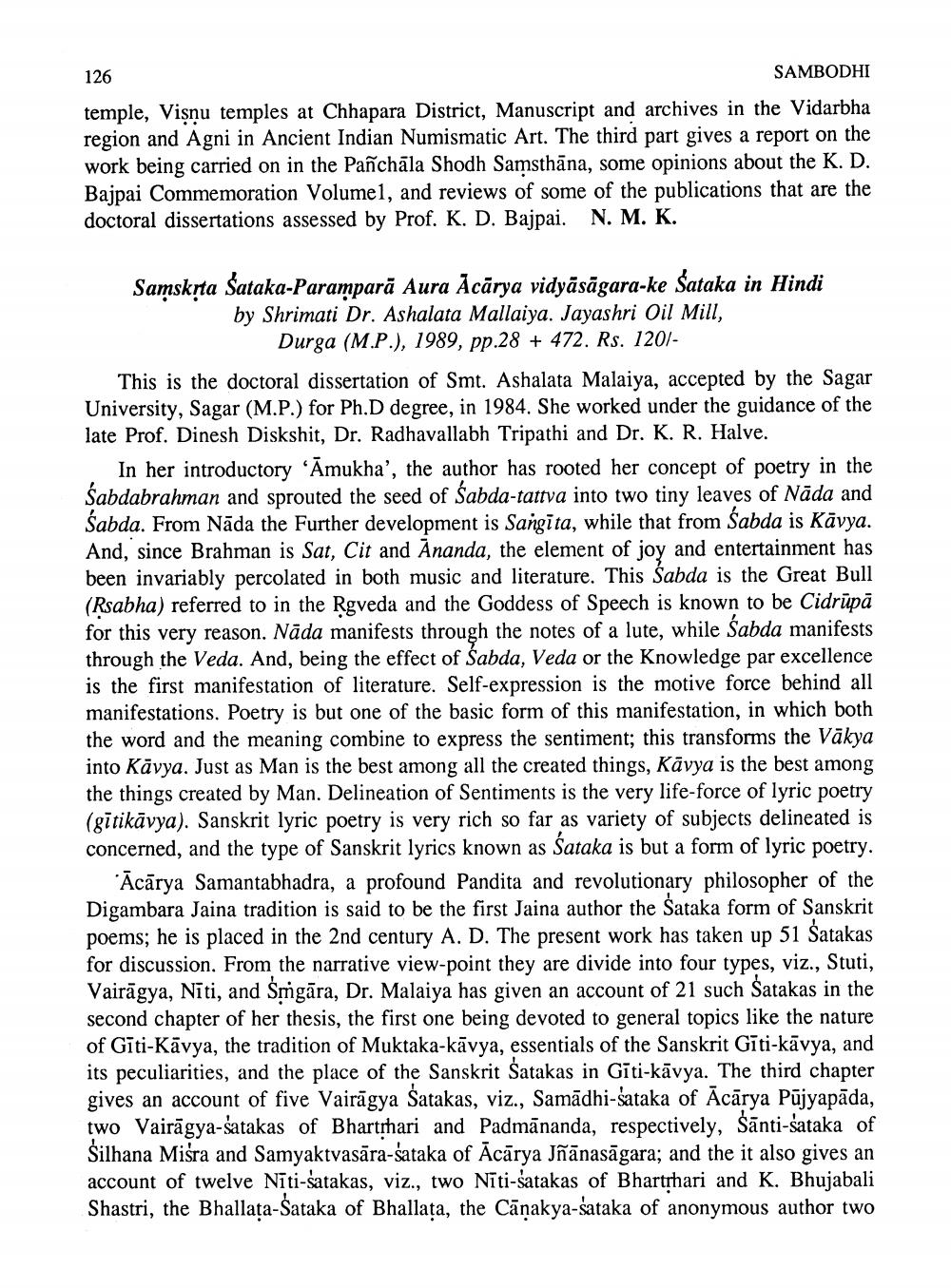________________
126
SAMBODHI temple, Visnu temples at Chhapara District, Manuscript and archives in the Vidarbha region and Agni in Ancient Indian Numismatic Art. The third part gives a report on the work being carried on in the Pañchāla Shodh Samsthāna, some opinions about the K. D. Bajpai Commemoration Volumel, and reviews of some of the publications that are the doctoral dissertations assessed by Prof. K. D. Bajpai. N. M. K.
Samskrta Šataka-Paramparā Aura Ācārya vidyāsāgara-ke Šataka in Hindi
by Shrimati Dr. Ashalata Mallaiya. Jayashri Oil Mill,
Durga (M.P.), 1989, pp.28 + 472. Rs. 120/This is the doctoral dissertation of Smt. Ashalata Malaiya, accepted by the Sagar University, Sagar (M.P.) for Ph.D degree, in 1984. She worked under the guidance of the late Prof. Dinesh Diskshit, Dr. Radhavallabh Tripathi and Dr. K. R. Halve.
In her introductory 'Āmukha', the author has rooted her concept of poetry in the Sabdabrahman and sprouted the seed of Sabda-tattva into two tiny leaves of Nāda and
bda. From Nāda the Further development is Sangīta, while that from Sabda is Kāvya And, since Brahman is Sat, Cit and Ananda, the element of joy and entertainment has been invariably percolated in both music and literature. This Sabda is the Great Bull (Rsabha) referred to in the Rgveda and the Goddess of Speech is known to be Cidrūpā for this very reason. Nāda manifests through the notes of a lute, while Sabda manifests through the Veda. And, being the effect of Sabda, Veda or the Knowledge par excellence is the first manifestation of literature. Self-expression is the motive force behind all manifestations. Poetry is but one of the basic form of this manifestation, in which both the word and the meaning combine to express the sentiment; this transforms the Vākya into Kāvya. Just as Man is the best among all the created things, Kāvya is the best among the things created by Man. Delineation of Sentiments is the very life-force of lyric poetry (gītikāvya). Sanskrit lyric poetry is very rich so far as variety of subjects delineated is concerned, and the type of Sanskrit lyrics known as Sataka is but a form of lyric poetry.
'Ācārya Samantabhadra, a profound Pandita and revolutionary philosopher of the Digambara Jaina tradition is said to be the first Jaina author the Šataka form of Sanskrit poems; he is placed in the 2nd century A. D. The present work has taken up 51 Šatakas for discussion. From the narrative view-point they are divide into four types, viz., Stuti, Vairāgya, Nīti, and Smgāra, Dr. Malaiya has given an account of 21 such Satakas in the second chapter of her thesis, the first one being devoted to general topics like the nature of Gīti-Kāvya, the tradition of Muktaka-kāvya, essentials of the Sanskrit Gīti-kāvya, and its peculiarities, and the place of the Sanskrit Satakas in Gīti-kāvya. The third chapter gives an account of five Vairāgya Satakas, viz., Samādhi-Sataka of Acārya Pūjyapāda, two Vairāgya-satakas of Bharthari and Padmānanda, respectively, Sānti-sataka of Šilhana Misra and Samyaktvasāra-sataka of Ācārya Jñānasāgara; and the it also gives an account of twelve Nīti-satakas, viz., two Nīti-satakas of Bhartrhari and K. Bhujabali Shastri, the Bhallata-Šataka of Bhallata, the Cāņakya-sataka of anonymous author two




